Experimental Outdoor Public Lighting Installation Powered by a Hydraulic Turbine Installed in the Municipal Water Supply Network
Abstract
:1. Introduction
- Solar Thermal: Solar collectors on the rooftops of municipal buildings, swimming pool facilities, sport buildings and schools, including both flat-plate and parabolic solar collectors [19].
- Wind Energy: Promotion of locally owned wind turbines [20].
- Hydroelectric Power: Mini-hydroelectric plants constructed on municipal waterworks where rivers are available. This solution, however, is encountering social rejection due to the associated negative environmental impacts [21].
- Combined Heat and Power: Simultaneous production of heat and power in cogeneration plants and biomass-based combined heat and power plants [23].
- Waste Management: Upholding the need for separate waste collection to increase the recycling of municipal solid waste and the use of organic waste for biogas production. Wastewater Treatment Plants (WWTPs) provide bioenergy based on cooking fats and oils, road grit and nutrients such as carbon, nitrogen and phosphorous [24,25].
- Water Distribution Management: The potential for energy recovery exists at any point within a water distribution system where the mechanical energy of excess water pressure can be converted into electrical energy. This energy conversion decreases the average operating pressure within a system, which, in turn, reduces water losses from leakages in the system [26].
2. Materials and Methods
2.1. Description of the Drinking Water Distribution Network
2.2. Design Premise and Optimal Location of the ERT
2.3. Description of the Experiment Station
- One battery bank with a nominal voltage of 24 VDC and a capacity of 220 Ah. It combined 2 units of 12 VDC 220 Ah deep-cycle, maintenance-free AGM blocks connected in series. The energy produced during the day was stored in this equipment.
- A 230 VAC/50 Hz single-phase inverter. It allowed the energy generated or stored to be used to feed a conventional lighting electrical distribution network.
- A control center integrated in a 600 mm × 600 mm × 210 mm IP66 metal box, which included:
- ⚬
- A battery charge regulator, which was responsible for protecting the batteries from deep discharge, if necessary, by disconnecting the load. In addition, it was able to send a signal to the solenoid valve to regulate the flow that circulated through the ERT when the battery bank was charged and there was no consumption at that time.
- ⚬
- A gear indicator pilot and a run/stop/auto-operating mode selector.
2.4. Measurement System: Equipment
- Two pressure transducers placed at the inlet and outlet of the turbine to measure the net pressure drop in the turbine in real time;
- One pulse counter (10 L/pulse) to measure the flow driven through the turbine;
- One power meter using a 4/20 mA current sensor to know the electric power that was being generated.
2.5. Description of the Public Lighting Installation Used as a Load
3. Results
3.1. Measurements of the Circulating Flow under Study
3.2. Working Conditions of the ERT
4. Discussion
4.1. Energy Conversion Efficiency
- P: Generated power [W]
- ΔH: Pressure jump in the turbine or pressure drop in the PVR [m]
- Q: Water flow through the turbine [m3/s]
- η: Global system performance. η = ηelectric × ηhydraulic
- ρ: Water density: 1000 [kg/m3]
- g: Gravity: 9.81 [m/s2]
4.2. Maximum Load to Be Powered and Optimized Battery Capacity
4.3. Comparison with the Requirements of a Stand-Alone PV Installation
Econsumed = (Ploads × tloads/Vstorage) × ηinverter = (770.81 W × 14.5 h/24 VDC) × 0.9 = 517.44 Ah/d
Ecorrected = Econsumed/(ηwires × ηbatteries) = 517.44 Ah/d/(0.98 × 0.90) = 586.67 Ah/d
Battery Capacity = (N° of days × Ecorrected)/(Max depth of discharge × Tcorrection factor)
Battery Capacity = (3 d × 586.67 Ah/d)/(0.85 × 0.80) = 2588.24 Ah
4.4. Data Extrapolation Using the Totel Energy Recovery Capacity of the Water Network under Study
- Use the full mean water flow of the main pipe where the PVR is installed (400 mm diameter section) from the data measured for the month of September.
- Choose ERT equipment appropriated for this amount of flow, which works with optimum performance with a pressure drop of ΔH = 20 mH2O. This means a turbine with a Pnominal equal to 6.00 kW.
- Evaluate the maximum recoverable energy and estimate the installation costs.
- Extract civil and construction work costs from public databases for construction.
- Include a 3.33-year period of renewal of the batteries. This is the estimated battery duration with adequate working conditions for this equipment, according to its technical specifications and the level of use planned.
- Annual maintenance costs are based on the experience of the technicians of the municipality related to the general maintenance cost of their installations involving sensors and electronic control units. This would cover the replacement of small pieces and labor work costs.
- Obtaining the resulting payback and Internal Rate of Return for 10 years (IRR) of the expected inversion is needed.
5. Conclusions
Author Contributions
Funding
Institutional Review Board Statement
Informed Consent Statement
Data Availability Statement
Acknowledgments
Conflicts of Interest
References
- European Commission. Energy Roadmap 2050; Publications Office of the European Union: Luxembourg, 2012; ISBN 978-92-79-21798-2. [Google Scholar] [CrossRef]
- Dupont, C.; Oberthür, S. Chapter 20: The European Union. In Research Handbook on Climate Governance; Bäckstrand, K., Lövbrand, E., Eds.; Edward Elgar Publishing: Cheltenham, UK, 2015; pp. 224–236. [Google Scholar] [CrossRef]
- Ceglia, F.; Esposito, P.; Marrasso, E.; Sasso, M. From smart energy community to smart energy municipalities: Literature review, agendas and pathways. J. Clean. Prod. 2020, 254, 120118. [Google Scholar] [CrossRef]
- De Coninck, H.; Revi, A.; Babiker, M.; Bertoldi, P.; Buckeridge, M.; Cartwright, A.; Dong, W.; Ford, J.; Fuss, S.; Hourcade, J.C.; et al. Strengthening and Implementing the Global Response. In Global Warming of 1.5 °C. An IPCC Special; MassonDelmotte, V., Zhai, P., Pörtner, H.O., Roberts, D., Skea, J., Shukla, P.R., Pirani, A., Moufouma-Okia, W., Péan, C., Pidcock, R., Connors, S., et al., Eds.; Intergovernmental Panel on Climate Change: Geneva, Switzerland, 2018; pp. 313–443. [Google Scholar]
- European Commission. Clean Energy for all Europeans Package. 2019. Available online: https://ec.europa.eu/energy/topics/energy-strategy/clean-energy-all-europeans_en (accessed on 19 August 2021).
- Ghiani, E.; Giordano, A.; Nieddu, A.; Rosetti, L.; Pilo, F. Planning of a smart local energy community: The case of Berchidda municipality (Italy). Energies 2019, 12, 4629. [Google Scholar] [CrossRef] [Green Version]
- Baleta, J.; Mikulčić, H.; Klemeš, J.J.; Urbaniec, K.; Duić, N. Integration of energy, water and environmental systems for a sustainable development. J. Clean. Prod. 2019, 215, 1424–1436. [Google Scholar] [CrossRef]
- Ruggiero, S.; Varho, V.; Rikkonen, P. Transition to distributed energy generation in Finland: Prospects and barriers. Energy Policy 2015, 86, 433–443. [Google Scholar] [CrossRef]
- Blanchet, T. Struggle over energy transition in Berlin: How do grassroots initiatives affect local energy policy-making? Energy Policy 2015, 78, 246–254. [Google Scholar] [CrossRef]
- Hoicka, C.E.; Conroy, J.; Berka, A.L. Reconfiguring actors and infrastructure in city renewable energy transitions: A regional perspective. Energy Policy 2021, 158, 112544. [Google Scholar] [CrossRef]
- Gutberlet, J. Waste to energy, wasting resources and livelihoods. In Integrated Waste Management; Sunil-Kumar, S., Ed.; IntechOpen: London, UK, 2011; Volume 1, pp. 219–236. [Google Scholar] [CrossRef]
- Engelken, M.; Römer, B.; Drescher, M.; Welpe, I. Transforming the energy system: Why municipalities strive for energy self-sufficiency. Energy Policy 2016, 98, 365–377. [Google Scholar] [CrossRef]
- Müller, M.O.; Stämpfli, A.; Dold, U.; Hammer, T. Energy autarky: A conceptual framework for sustainable regional development. Energy Policy 2011, 39, 5800–5810. [Google Scholar] [CrossRef]
- Koirala, B.P.; Koliou, E.; Friege, J.; Hakvoort, R.A.; Herder, P.M. Energetic communities for community energy: A review of key issues and trends shaping integrated community energy systems. Renew. Sust. Energ. Rev. 2016, 56, 722–744. [Google Scholar] [CrossRef] [Green Version]
- Kona, A.; Bertoldi, P.; Kılkış, Ş. Covenant of mayors: Local energy generation, methodology, policies and good practice examples. Energies 2019, 12, 985. [Google Scholar] [CrossRef] [Green Version]
- Suwa, A. Renewable energy and regional value: Identifying value added of public power producer and suppliers in japan. Fin. Res. Lett. 2020, 37, 101365. [Google Scholar] [CrossRef]
- Numbi, B.P.; Malinga, S.J. Optimal energy cost and economic analysis of a residential grid-interactive solar PV system-case of eThekwini municipality in South Africa. Appl. Energy 2017, 186, 28–45. [Google Scholar] [CrossRef]
- Prina, M.G.; Cozzini, M.; Garegnani, G.; Moser, D.; Oberegger, U.F.; Vaccaro, R.; Sparber, W. Smart energy systems applied at urban level: The case of the municipality of Bressanone-Brixen. Int. J. Sustain. Energy Plan. Manag. 2016, 10, 33–52. [Google Scholar] [CrossRef]
- Azevêdo, V.W.B.; Candeias, A.L.B.; Tiba, C. Location study of solar thermal power plant in the state of Pernambuco using geoprocessing technologies and multiple-criteria analysis. Energies 2017, 10, 1042. [Google Scholar] [CrossRef] [Green Version]
- Østergaard, P.A.; Mathiesen, B.V.; Möller, B.; Lund, H. A renewable energy scenario for Aalborg Municipality based on low-temperature geothermal heat, wind power and biomass. Energy 2010, 35, 4892–4901. [Google Scholar] [CrossRef]
- Magnani, N. Beyond NIMBY: Mobilization against mini-hydroelectric power in the Italian alps. Mt. Res. Dev. 2020, 40, 31–36. [Google Scholar] [CrossRef]
- Weinand, J.M.; McKenna, R.; Kleinebrahm, M.; Mainzer, K. Assessing the contribution of simultaneous heat and power generation from geothermal plants in off-grid municipalities. Appl. Energy 2019, 255, 113824. [Google Scholar] [CrossRef]
- Beiron, J.; Normann, F.; Johnsson, F. A Case Study of the Potential for CCS in Swedish Combined Heat and Power Plants. In Proceedings of the 15th Greenhouse Gas Control Technologies Conference, Lyon, France, 15–18 March 2021; Available online: https://ssrn.com/abstract=3811373 (accessed on 18 February 2022).
- Kollmann, R.; Neugebauer, G.; Kretschmer, F.; Truger, B.; Kindermann, H.; Stoeglehner, G.; Narodoslawsky, M. Renewable energy from wastewater-Practical aspects of integrating a wastewater treatment plant into local energy supply concepts. J. Clean. Prod. 2017, 155, 119–129. [Google Scholar] [CrossRef]
- Cudjoe, D.; Han, M.S. Economic and environmental assessment of landfill gas electricity generation in urban districts of Beijing municipality. Sustain. Prod. Consum. 2020, 23, 128–137. [Google Scholar] [CrossRef]
- Pérez-Sánchez, M.; Sánchez-Romero, F.J.; Ramos, H.M.; López-Jiménez, P.A. Energy recovery in existing water networks: Towards greater sustainability. Water 2017, 9, 97. [Google Scholar] [CrossRef] [Green Version]
- Corcoran, L.; Coughland, P.; McNabola, A. Energy recovery potential using micro hydropower in water supply networks in the UK and Ireland. Water Sci. Tech. Water Supply 2013, 13, 552–560. [Google Scholar] [CrossRef]
- Carravetta, A.; Del Giudice, G.; Fecarotta, O.; Ramos, H.M. PAT design strategy for energy recovery in water distribution networks by electrical regulation. Energies 2013, 6, 411–424. [Google Scholar] [CrossRef] [Green Version]
- McNabola, A.; Coughlan, P.; Corcoran, L.; Power, C.; Prysor Williams, A.; Harris, I.; Gallagher, J.; Styles, D. Energy recovery in the water industry using micro-hydropower: An opportunity to improve sustainability. Water Policy 2014, 16, 168–183. [Google Scholar] [CrossRef]
- Carravetta, A.; Fecarotta, O.; Del Giudice, G.; Ramos, H. Energy recovery in water systems by PATs: A comparisons among the different installation schemes. Procedia Eng. 2014, 70, 275–284. [Google Scholar] [CrossRef] [Green Version]
- Su, P.A.; Karney, B. Micro hydroelectric energy recovery in municipal water systems: A case study for Vancouver. Urban Water J. 2015, 12, 678–690. [Google Scholar] [CrossRef]
- Samora, I.; Manso, P.; Franca, M.J.; Schleiss, A.J.; Ramos, H.M. Energy recovery using micro-hydropower technology in water supply systems: The case study of the city of Fribourg. Water 2016, 8, 344. [Google Scholar] [CrossRef] [Green Version]
- Patelis, M.; Kanakoudis, V.; Gonelas, K. Pressure management and energy recovery capabilities using PATs. Procedia Eng. 2016, 162, 503–510. [Google Scholar] [CrossRef]
- Lydon, T.; Coughlan, P.; McNabola, A. Pressure management and energy recovery in water distribution networks: Development of design and selection methodologies using three pump-as-turbine case studies. Renew. Energy 2017, 114, 1038–1050. [Google Scholar] [CrossRef]
- Lima, G.M.; Brentan, B.M.; Luvizotto, E., Jr. Optimal design of water supply networks using an energy recovery approach. Renew. Energy 2018, 117, 404–413. [Google Scholar] [CrossRef]
- Carravetta, A.; Fecarotta, O.; Ramos, H. A new low-cost installation scheme of PATs for pico-hydropower to recover energy in residential areas. Renew. Energy 2018, 125, 1003–1014. [Google Scholar] [CrossRef]
- Fernández-García, I.; Ferras, D.; Mc Nabola, A. Potential of energy recovery and water saving using micro-hydropower in rural water distribution networks. J. Water Resour. Plan. Manag.-ASCE 2019, 145, 05019001. [Google Scholar] [CrossRef]
- Bonthuys, G.J.; Van Dijk, M.; Cavazzini, G. Energy recovery and leakage-reduction optimization of water distribution systems using hydro turbines. J. Water Resour. Plan. Manag. ASCE 2020, 146, 04020026. [Google Scholar] [CrossRef]
- Novara, D.; McNabola, A. Design and Year-Long Performance Evaluation of a Pump as Turbine (PAT) Pico-Hydropower Energy Recovery Device in a Water Network. Water 2021, 13, 3014. [Google Scholar] [CrossRef]
- Mesquita, A.L.A.; Blanco, C.J.C. Pump-as-turbine for energy recovery in municipal water supply networks. A review. J. Braz. Soc. Mech. Sci. Eng. 2021, 43, 489. [Google Scholar] [CrossRef]
- Telci, I.T.; Aral, M.M. Optimal energy recovery from water distribution systems using smart operation scheduling. Water 2018, 10, 1464. [Google Scholar] [CrossRef] [Green Version]
- Alberizzi, J.C.; Renzi, M.; Nigro, A.; Rossi, M. Study of a Pump-as-Turbine (PaT) speed control for a Water Distribution Network (WDN) in South-Tyrol subjected to high variable water flow rates. Energy Procedia 2018, 148, 226–233. [Google Scholar] [CrossRef]
- Stefanizzi, M.; Capurso, T.; Balacco, G.; Binetti, M.; Camporeale, S.M.; Torresi, M. Selection, control and techno-economic feasibility of Pumps as Turbines in Water Distribution Networks. Renew. Energy 2020, 162, 1292–1306. [Google Scholar] [CrossRef]
- Satish, D.; Doshi, A.; Bade, M. Review on Pump as Turbine Application in Water Distribution Networks for Power Generation. In AIP Conference Proceedings; AIP Publishing LLC: Melville, NY, USA, 2021; Volume 2341, p. 030035. [Google Scholar] [CrossRef]
- Fontanella, S.; Fecarotta, O.; Molino, B.; Cozzolino, L.; Della Morte, R. A Performance Prediction Model for Pumps as Turbines (PATs). Water 2020, 12, 1175. [Google Scholar] [CrossRef] [Green Version]
- Balacco, G.; Binetti, M.; Capurso, T.; Stefanizzi, M.; Torresi, M.; Piccinni, A.F. Pump as Turbine for the Energy Recovery in a Water Distribution Network: Two Italian (Apulian) Case Studies. Environ. Sci. Proc. 2020, 2, 1. [Google Scholar] [CrossRef]
- Binama, M.; Su, W.T.; Li, X.B.; Li, F.C.; Wei, X.Z.; An, S. Investigation on pump as turbine (PAT) technical aspects for micro hydropower schemes: A state-of-the-art review. Renew. Sust. Energ. Rev. 2017, 79, 148–179. [Google Scholar] [CrossRef]
- Montoya, F.G.; Peña-García, A.; Juaidi, A.; Manzano-Agugliaro, F. Indoor Lighting Techniques: An Overview of Evolution and New Trends for Energy Saving. Energy Build. 2017, 140, 50–60. [Google Scholar] [CrossRef]
- Sei-Ping, F.; Weddell, A.S.; Merrett, G.V.; White, N.M. Energy-Neutral Solar-Powered Street Lighting with Predictive and Adaptive Behaviour. In Proceedings of the 2nd International Workshop on Energy Neutral Sensing Systems, New York, NY, USA, 30 May 2018; pp. 13–18. [Google Scholar]
- Prescient & Strategic Intelligence Private Limited. Solar Street Lighting Market; Report Code: SE11228; Prescient & Strategic Intelligence Private Limited: Delhi, India, 2020. [Google Scholar]
- MNRE (Ministry of New and Renewable Energy). Launch of Atal Jyoti Yojana (AJAY): Phase II; NO 32/30/2018-SPV; Lodhi Road; Goberment of India: New Delhi, India, 2018. Available online: https://mnre.gov.in/img/documents/uploads/file_f-1583485483869.pdf (accessed on 16 February 2022).
- Solar Power Europe. Global Market Outlook For Solar Power 2021—2025; Solar Power Europe: Brussels, Belgium, 2021; ISBN 9789464073492. [Google Scholar]
- Ocana-Miguel, A.; Andres-Diaz, J.R.; Navarrete-de Galvez, E.; Gago-Calderon, A. Adaptation of an Insulated Centralized Photovoltaic Outdoor Lighting Installation with Electronic Control System to Improve Service Guarantee in Tropical Latitudes. Sustainability 2021, 13, 1925. [Google Scholar] [CrossRef]
- Tallini, A.; Vallati, A.; Cedola, L. Applications of micro-CAES systems: Energy and economic analysis. Energy Procedia 2015, 82, 797–804. [Google Scholar] [CrossRef] [Green Version]
- Besharat, M.; Dadfar, A.; Viseu, M.T.; Brunone, B.; Ramos, H.M. Transient-flow induced compressed air energy storage (TI-CAES) system towards new energy concept. Water 2020, 12, 601. [Google Scholar] [CrossRef] [Green Version]
- Hernández-Callejo, L.; Gallardo-Saavedra, S.; Alonso-Gómez, V. A review of photovoltaic systems: Design, operation and maintenance. Sol. Energy 2019, 188, 426–440. [Google Scholar] [CrossRef]
- Rodríguez-Pérez, Á.M.; Pérez-Calañas, C.; Pulido-Calvo, I. Energy Recovery in Pressurized Hydraulic Networks. Water Resour Manag. 2021, 35, 1977–1990. [Google Scholar] [CrossRef]
- Rippl, W. The Capacity of Storage-Reservoirs for Water Supply. In Minutes of the Proceedings of the Institution of Civil Engineers; Thomas Telford-ICE Virtual Library: London, UK, 1883; Volume 71, pp. 270–278. ISSN 1753-7843. [Google Scholar]
- Solar Energy International. Photovoltaics: Design and Installation Manual; New Society Publishers: Gabriola Island, BC, Canada, 2004; ISBN1 9781550924046. Available online: https://www.solarpowereurope.org/wp-content/uploads/2021/07/SolarPower-Europe_Global-Market-Outlook-for-Solar-2021-2025_V1.pdf (accessed on 18 February 2022)ISBN2 9781550924046.
- Sancho Ávila, J.M.; Riesco Martín, J.; Jiménez Alonso, C.; Sánchez de Cos, M.D.C.; Montero Cadalso, J.; López Bartolomé, M. Atlas de Radiación Solar en España Utilizando datos del SAF de Clima de EUMETSAT. AEMET. 2012. Available online: http://www.aemet.es/documentos/es/serviciosclimaticos/datosclimatologicos/atlas_radiacion_solar/atlas_de_radiacion_24042012.pdf (accessed on 18 February 2022).
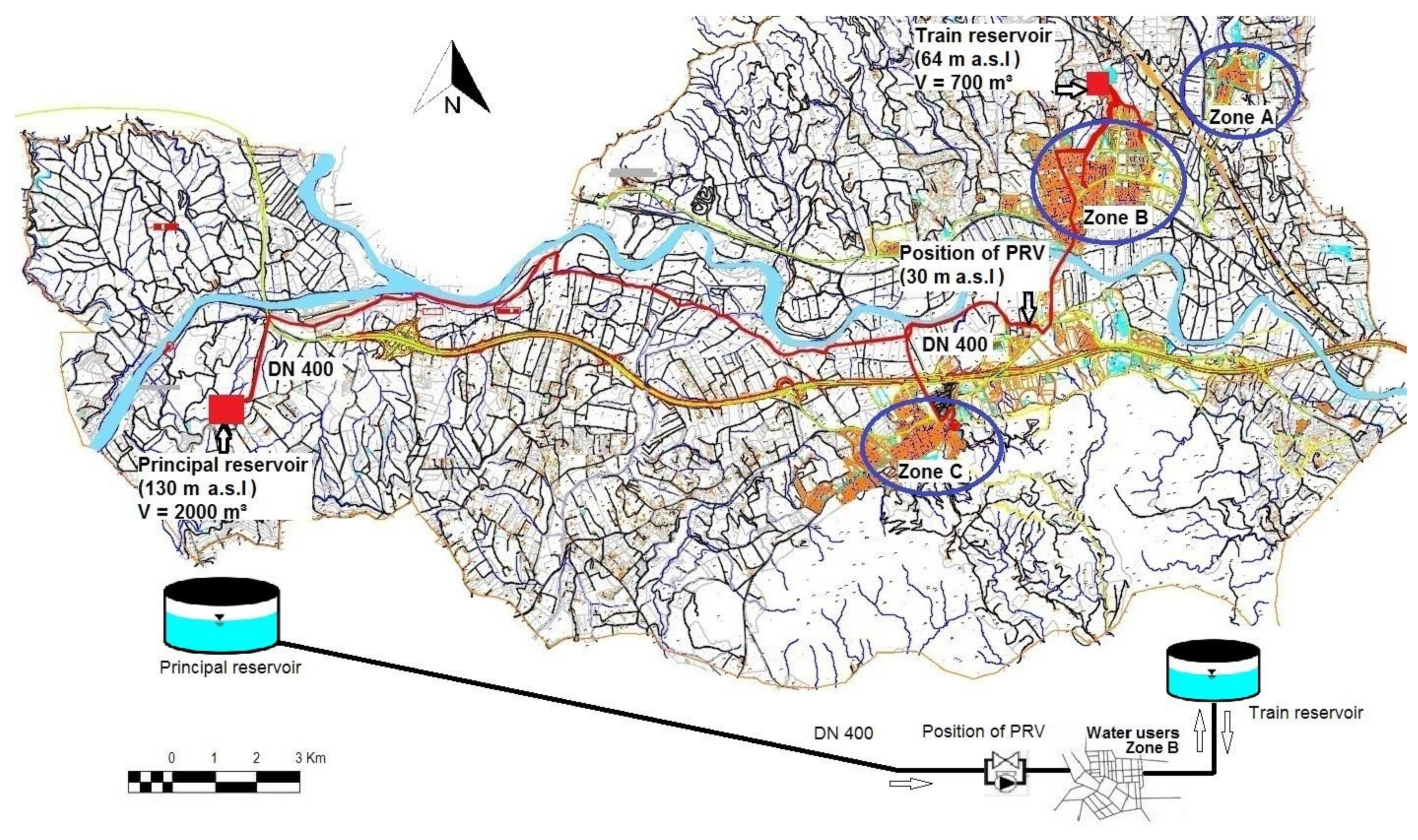





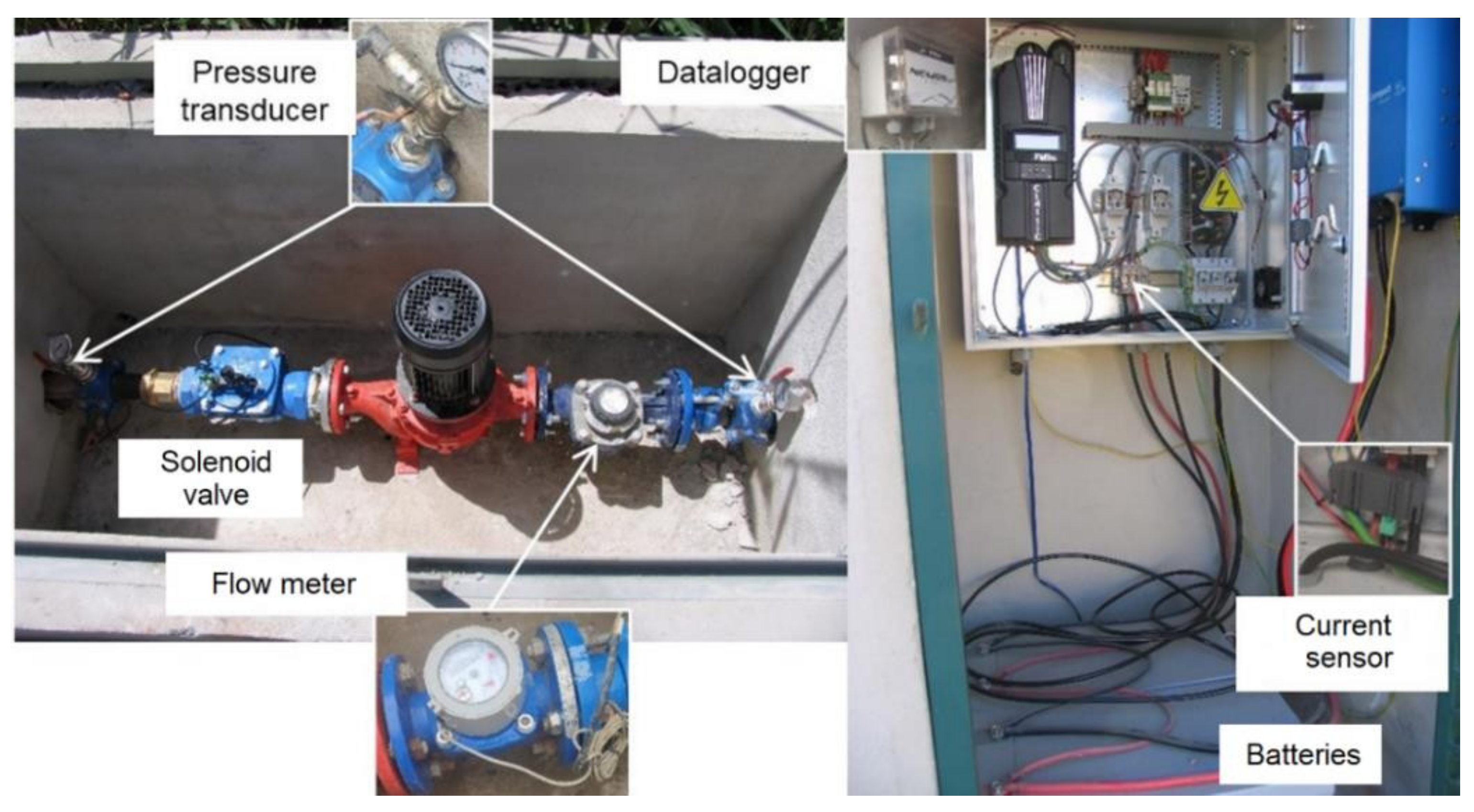
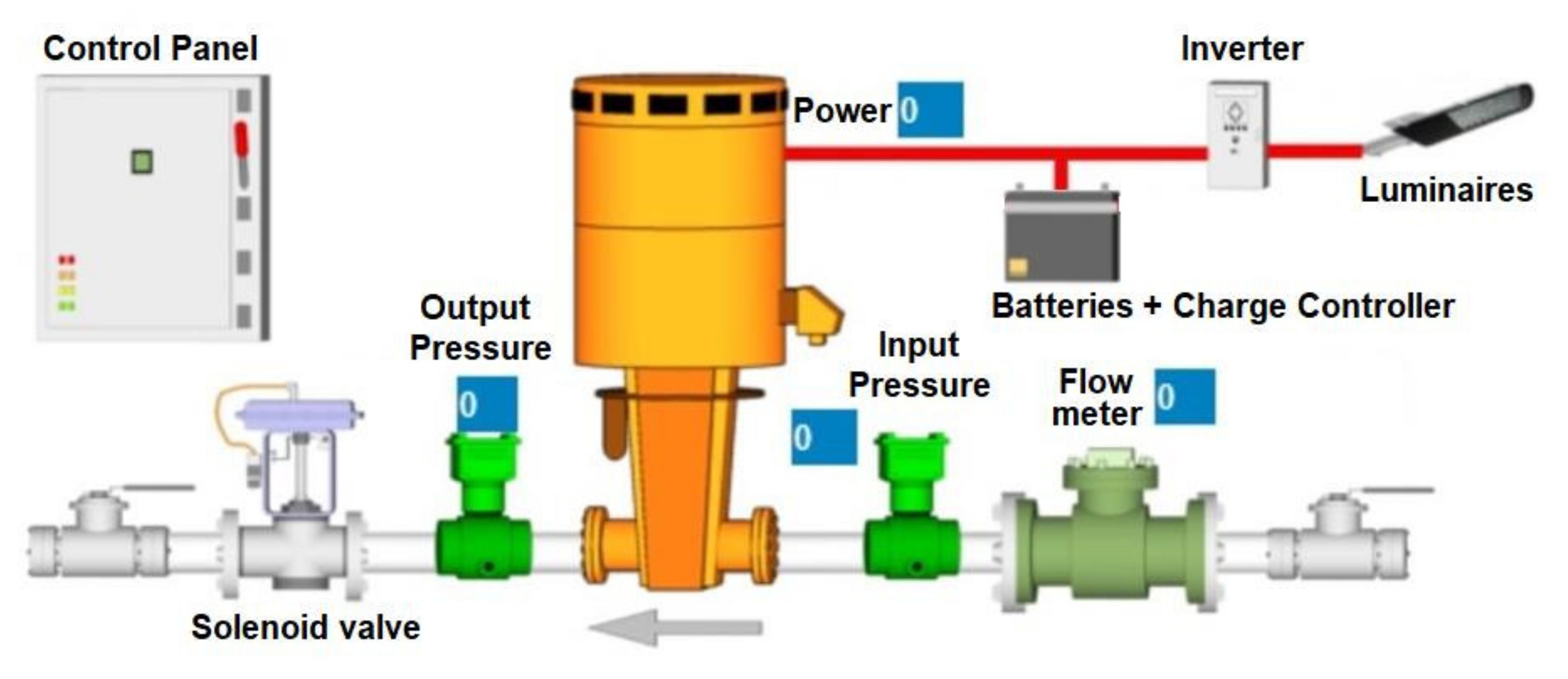
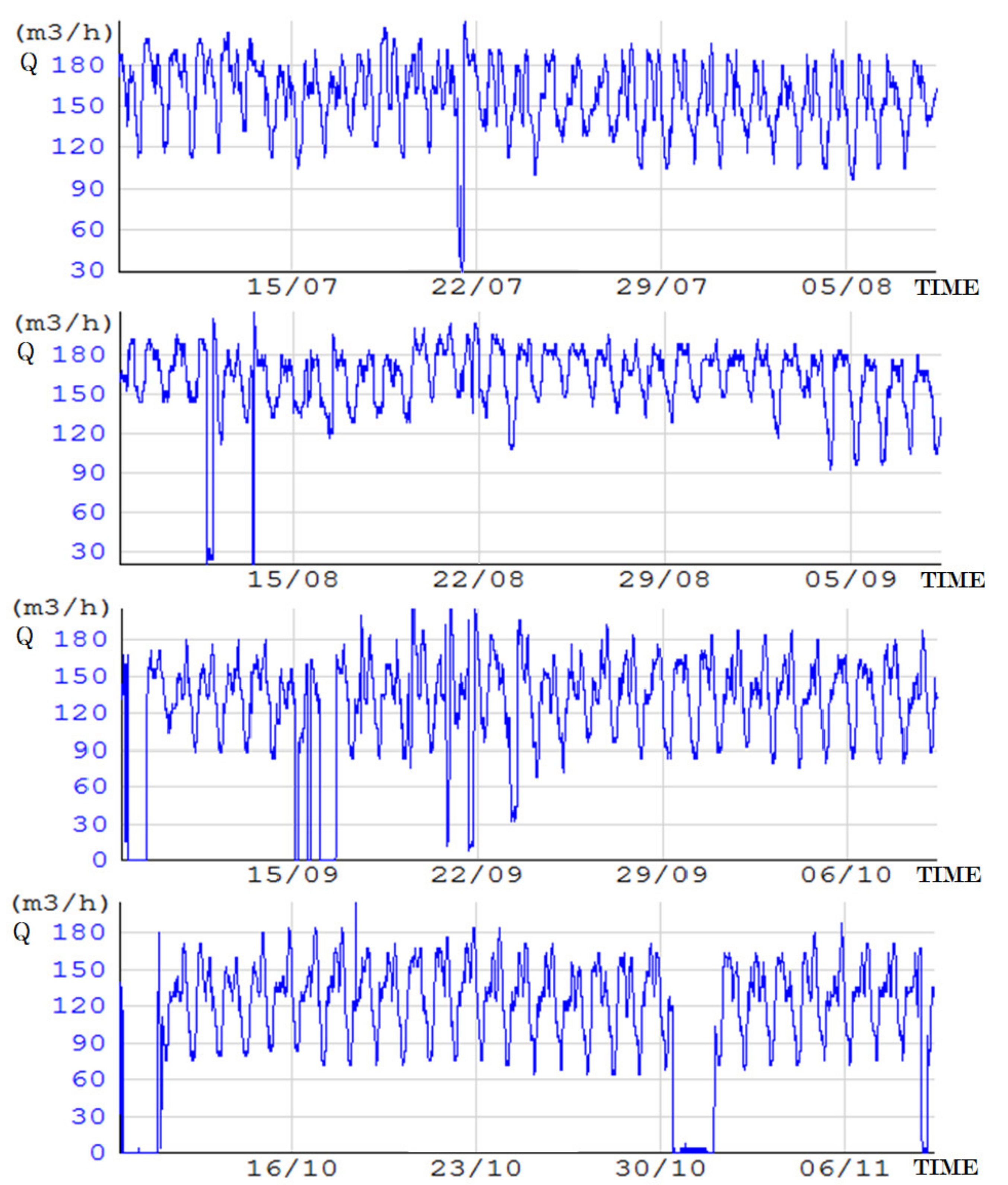


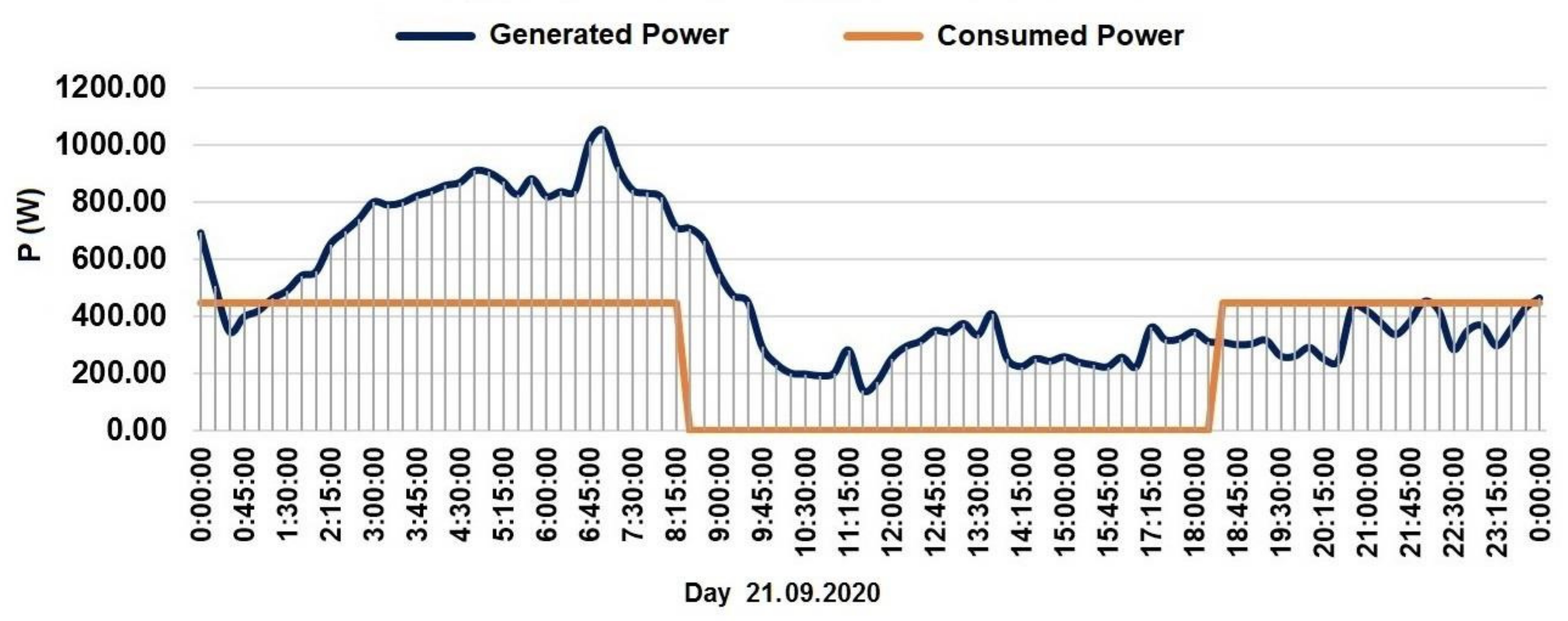

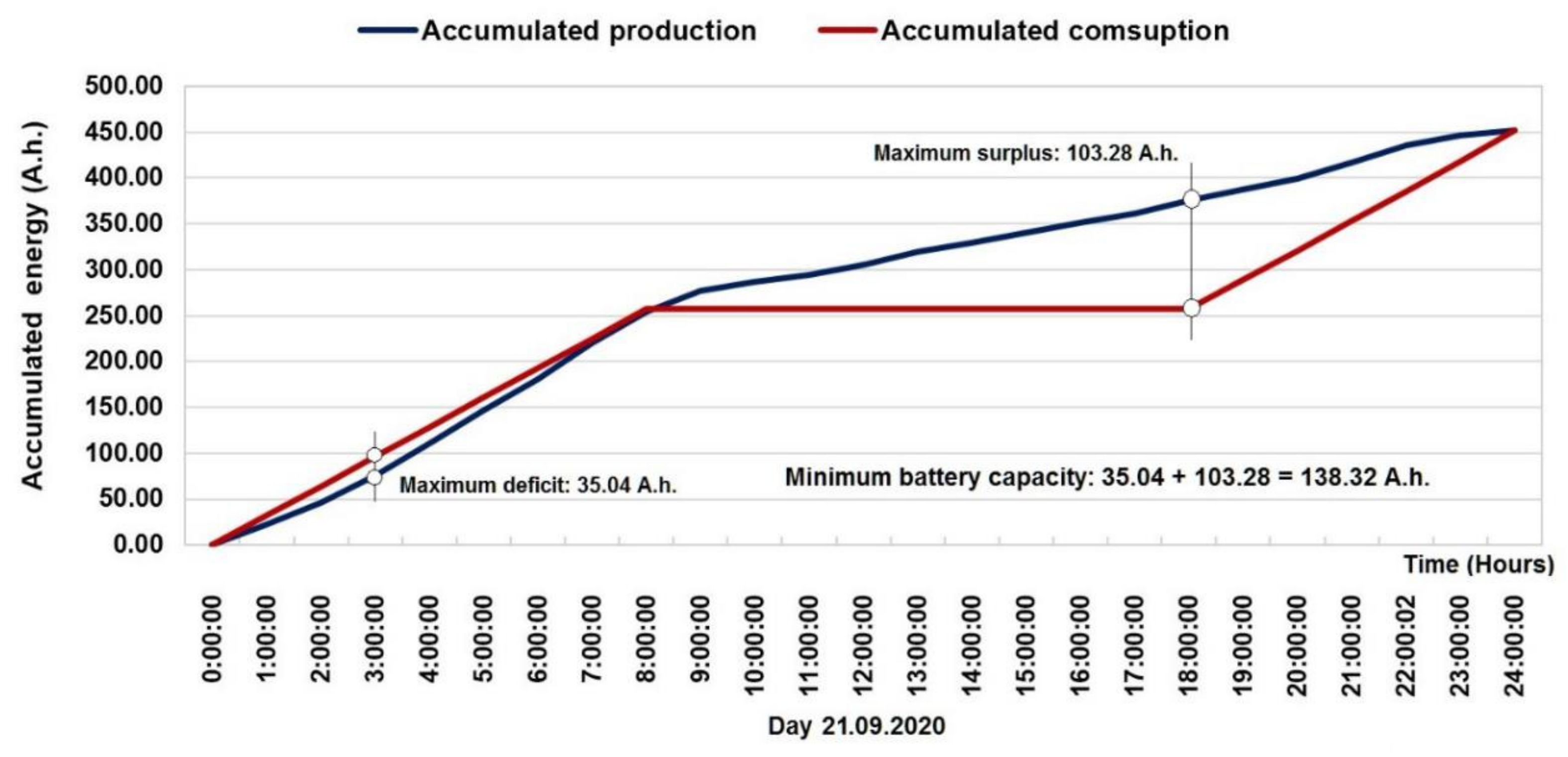
| Vertical Axis Hydraulic Turbine (×1) | |
|---|---|
| Model and Manufacturer | 050-B0//Tecnoturbines S.L. |
| Nominal power | 1.6 kW |
| Inlet and outlet diameter | 50 mm |
| Body and impeller material | Gray iron castings |
| Flow rate and nominal pressure | 13.5 L/s//20.0 mH2O |
| Efficiency generator | 85% |
| Price per unit | €2173.14 |
| Battery Module (×2) | |
| Model and Manufacturer | Meba-12/20//Bornay |
| Technology | AGM |
| Nominal voltage | 12 VDC |
| Nominal Capacity (C10) | 220 Ah |
| Useful Capacity (80% discharge) | 176 Ah |
| Price per unit | €410.00 |
| ERT Control Panel (×1) | |
| Model and Manufacturer | SN HE 000//Tecnoturbines S.L. |
| Maximum voltage Battery voltage | 3 × 142 VDC 24 VDC |
| Maximum battery current | 100 A |
| Price per unit | €2583.04 |
| Inverter (×1) | |
| Model and Manufacturer | Phoenix 24/1600//Victron Energy |
| Input voltage | 24 VDC (Range 19–33 VDC) |
| Output voltage | 230 VAC-50 Hz |
| AC power output | 1300 W @25 °C/1200 W @40 °C |
| Conversion efficiency | 94% |
| Price per unit | €813.00 |
| Solenoide Valve (×1) | |
| Model and Manufacturer | GGG40//Hidroconta |
| Input voltage | 12 VDC |
| Nominal pressure | 0.16 Pa |
| Price per unit | €220.23 |
| Datalogger (×1) | |
|---|---|
| Model and Manufacturer | Nemos LP GPRS//Microcom |
| Input power | 5–15 VDC (40 mA) |
| Communications Digital//Analog inputs Memory | Siemens MC55 i GSM Modem 8//4 Flash 256 kB |
| Price per unit | €399.00 |
| Water Meter (×1) | |
| Model and Manufacturer | WT//Conthidra S.L. |
| Nominal diameter | 50 mm |
| Maximum//minimum flow | 50 m3/h//1 m3/h |
| Permanent flow Pulse factor | 40 m3/h 10 L/impulse |
| Price per unit | €204.55 |
| Current Sensor Transformer (×1) | |
| Model and Manufacturer | AMPER 0//Remberg |
| Input voltage | 24 VDC (Range 11–35 VDC) |
| Measurement range | 0//50 ADC |
| Output signal | 4–20 mA |
| Price per unit | €32.80 |
| Pressure Transducer (×2) | |
| Model and Manufacturer | MBS 3000//Danfoss |
| Input voltage | 9–32 VDC |
| Measurement range | 0–16 Bar |
| Output signal | 4–20 mA |
| Price per unit | €115.00 |
| Energy Generation System. | Energy Storage Requirements (24 VDC) | Battery Modules C220 Ah (12 VDC) | Total Cost of Batteries |
|---|---|---|---|
| ERT | 138.32 Ah | 2 Units | €820.00 |
| PV modules | 2588.24 Ah * | 24 Units | €9840.00 |
| Economic savings | €9020.00 | ||
| Initial Investment | |
|---|---|
| Equipment (ERT generator + batteries + control box and taxes) | €8800.00 |
| Hydraulic installation | €1500.00 |
| Electric connection | €1200.00 |
| Civil works | €5000.00 |
| Commissioning | €1000.00 |
| Technical-Economic Data | |
| Nominal generation power | 6.00 kW |
| Production (hours per year) | 8322.00 h |
| Annual produced energy | 49,932.00 kW h |
| Energy price (AC grid) | €0.13/kW h |
| Annual savings (Electricity) | €6491.16 |
| Renewal period of the batteries | 3.33 years |
| Annual maintenance cost | €390.00 |
| Project Profitability | |
| Annual increase of the prices (average) | 2% |
| Payback | 3.79 year |
| Internal Rate of Return (10 years) | 24% |
Publisher’s Note: MDPI stays neutral with regard to jurisdictional claims in published maps and institutional affiliations. |
© 2022 by the authors. Licensee MDPI, Basel, Switzerland. This article is an open access article distributed under the terms and conditions of the Creative Commons Attribution (CC BY) license (https://creativecommons.org/licenses/by/4.0/).
Share and Cite
Ocana-Miguel, A.; Gago-Calderon, A.; Andres-Diaz, J.R. Experimental Outdoor Public Lighting Installation Powered by a Hydraulic Turbine Installed in the Municipal Water Supply Network. Water 2022, 14, 710. https://doi.org/10.3390/w14050710
Ocana-Miguel A, Gago-Calderon A, Andres-Diaz JR. Experimental Outdoor Public Lighting Installation Powered by a Hydraulic Turbine Installed in the Municipal Water Supply Network. Water. 2022; 14(5):710. https://doi.org/10.3390/w14050710
Chicago/Turabian StyleOcana-Miguel, Antonio, Alfonso Gago-Calderon, and Jose Ramon Andres-Diaz. 2022. "Experimental Outdoor Public Lighting Installation Powered by a Hydraulic Turbine Installed in the Municipal Water Supply Network" Water 14, no. 5: 710. https://doi.org/10.3390/w14050710
APA StyleOcana-Miguel, A., Gago-Calderon, A., & Andres-Diaz, J. R. (2022). Experimental Outdoor Public Lighting Installation Powered by a Hydraulic Turbine Installed in the Municipal Water Supply Network. Water, 14(5), 710. https://doi.org/10.3390/w14050710






